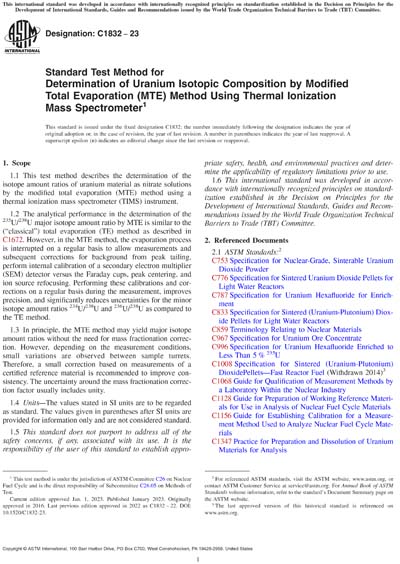Most recent
ASTM C1832-23
Standard Test Method for Determination of Uranium Isotopic Composition by Modified Total Evaporation (MTE) Method Using Thermal Ionization Mass Spectrometer
1.1This test method describes the determination of the isotope amount ratios of uranium material as nitrate solutions by the modified total evaporation (MTE) method using a thermal ionization mass spectrometer (TIMS) instrument.
1.2The analytical performance in the determination of the 235U/238U major isotope amount ratio by MTE is similar to the ("classical") total evaporation (TE) method as described in C1672. However, in the MTE method, the evaporation process is interrupted on a regular basis to allow measurements and subsequent corrections for background from peak tailing, perform internal calibration of a secondary electron multiplier (SEM) detector versus the Faraday cups, peak centering, and ion source refocusing. Performing these calibrations and corrections on a regular basis during the measurement, improves precision, and significantly reduces uncertainties for the minor isotope amount ratios 234U/238U and 236U/238U as compared to the TE method.
1.3In principle, the MTE method may yield major isotope amount ratios without the need for mass fractionation correction. However, depending on the measurement conditions, small variations are observed between sample turrets. Therefore, a small correction based on measurements of a certified reference material is recommended to improve consistency. The uncertainty around the mass fractionation correction factor usually includes unity.
1.4Units - The values stated in SI units are to be regarded as standard. The values given in parentheses after SI units are provided for information only and are not considered standard.
1.5This standard does not purport to address all of the safety concerns, if any, associated with its use. It is the responsibility of the user of this standard to establish appropriate safety, health, and environmental practices and determine the applicability of regulatory limitations prior to use.
1.6This international standard was developed in accordance with internationally recognized principles on standardization established in the Decision on Principles for the Development of International Standards, Guides and Recommendations issued by the World Trade Organization Technical Barriers to Trade (TBT) Committee.
Content Provider
ASTM International [astm]






